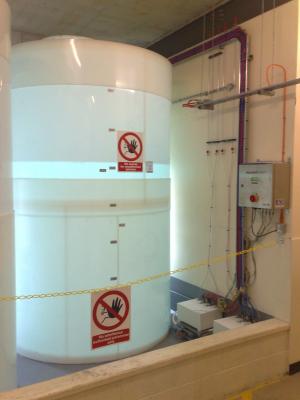- Group home
- You must register/login in order to post into this group.
Central Delivery of Acid for Haemodialysis

By: Bradford Teaching Hospitals NHS Foundation Trust
Reduced acid wastage: only the actual acid required for any given treatment is ever used. Reduced solid waste: in 2008, 29,540 used canisters were disposed of as clinical waste. Saving on storage space and manual handling by nurses and porters: it is no longer necessary to transport 90 full canisters from ground- to first floor every day. Resilience to disruption of supply: the unit now has 3 weeks’ supply of solution at any one time.
£22,900 (Actual)
16.03 tonnes CO2e per year (Estimated)
The dialysis unit was previously supplied with 6 litre plastic cans of dialysate acid solution through weekly orders. These were delivered on pallets and could not be stacked to save on storage space.
The Problem:
1. Acid Wastage
As dialysis patients are prescribed different flow rates (either 800ml/min or 500ml/min) there is generally always an element of acid wastage. More so is this seen with patients on a 500ml/min dialysate flow with approximately 2.14 litres not used out of the 6 litre can per treatment. Throughout one year this equated to a total wastage to drain of 50,142 litres. When considering the total order for St Lukes was 147,700 litres for 2008, this amounted to a high percentage of waste.
2. Waste Disposal:
Empty canisters weighed approx. 143 grams and were disposed of via the clinical waste stream at a cost of £500 per ton. This amounted to an annual cost of approximately £2,363 per year.
The Solution:
In 2009, the renal technicians proposed a move to central acid delivery. This is acid delivered to a dialysis unit in bulk load through fortnightly/monthly deliveries and pumped into holding tanks (delivery frequency depends on the size of holding tanks installed). This acid is then distributed to all dialysis machines via a piped loop system with outlets at each dialysis station. They noted that all the dialysis machines in use had the capability to be retrofitted with central delivery acid systems at minimal expense.
The new two-acid, two-loop system was installed in 2011, at a cost of £40,000. This comprises a 7000 litre storage tank for the main acid solution, a 4000 litre tank for the low calcium solution, and a pressurised loop to deliver the acid to the dialysis machines. The Trust also paid an additional £3,900 for enabling works – a bund system connected to an outside drain, in case of leakage.
Benefits to the environmental sustainability of kidney care (section updated November 2012)
1. Reduced Acid Wastage
Using 6 litre cannisters, the average acid wastage per dialysis session for a patient on a 500ml/min flow rate was 2.14 litres. Throughout one year this equated to a total wastage to drain of 50,142 litres.
At £0.38/ litre, the predicted savings were £19,054 exc. VAT per year. Actual savings achieved were £19,372 per year.
Multiplying this cost saving by the emissions factor for pharmaceuticals (2012 Guidelines to Defra / DECC's GHG Conversion Factors for Company Reporting, Annex 13) produces an estimate of carbon savings from avoided supply chain activities: 0.43 x 19,372 = 8,330 kg CO2e per year
2. Reduction in packaging waste
29540 empty canisters were previously disposed of per year (in 2008), each weighing 142.6 grams, amounting to 4.2 tonnes of plastic waste per year. The carbon savings from avoiding disposal of this waste via the clinical waste stream can be estimated at
4.2 x 1,833 (life-cycle GHG emissions factor for incineration)* = 7,699 kg CO2e
* DEFRA emissions factors for incineration do not specifically account for clinical waste, which is commonly undertaken at higher temperatures. To reflect the increased emissions that are likely to result from the incineration of clinical waste, the highest available emissions factor for incineration was applied (Table 9d, 2011 Guidelines to Defra / DECC's GHG Conversion Factors for Company Reporting)
[Combined savings = 16.03 tonnes CO2e per year]
Financial appraisal
Investment: £40,000 for storage tanks and piping; £3,900 for enabling works. Total: £43,900.
Actual savings: £19,372 per year from reduced acid wastage; £3,700 from reduced waste disposal. Total: £23,072 per year.
Return on investment at 5 years:
((Total saving to date - total cost to date) / (total cost to date)) * 100
((£23,072 * 5 - £43,900)/£43,900) * 100 = 163%
Renal Dialysis Unit, St Luke's Hospital, Bradford
To reduce acid wastage, packaging and money
Support from the Bradford Green Nephrology Local Representative, Dr John Stoves (consultant nephrologist)
Report published in the Trust newsletter ("Trust Today" March 2011, p8). Green Nephrology Awards 2012 - award entry poster available to download from http://sustainablehealthcare.org.uk/green-nephrology/resources/2012/09/green-nephrology-award-entries-2012-posters-d
